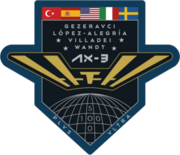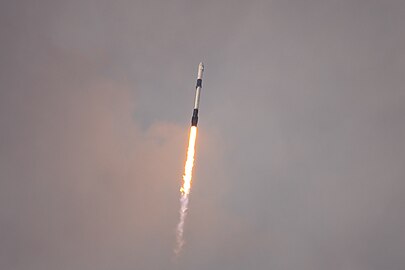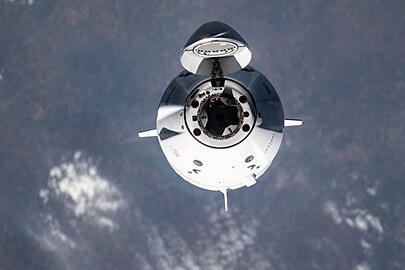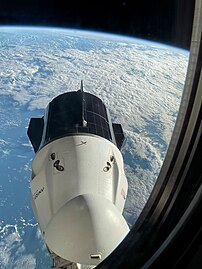Axiom Mission 3
 Launch of Ax-3 on a Falcon 9 rocket. | |
| Names | Ax-3 |
|---|---|
| Mission type | Private spaceflight to the ISS |
| Operator | Axiom Space |
| COSPAR ID | 2024-014A |
| SATCAT no. | 58815 |
| Mission duration | 21 days, 15 hours and 41 minutes |
| Spacecraft properties | |
| Spacecraft type | Crew Dragon Freedom |
| Manufacturer | SpaceX |
| Launch mass | 12,519 kg (27,600 lb) |
| Landing mass | 9,616 kg (21,200 lb) |
| Crew | |
| Crew size | 4 |
| Members |
|
| Start of mission | |
| Launch date | 18 January 2024 21:49 UTC[1] |
| Rocket | Falcon 9 Block 5 (B1080.5) |
| Launch site | Kennedy Space Center, LC-39A |
| Contractor | SpaceX |
| End of mission | |
| Recovered by | MV Shannon |
| Landing date | 9 February 2024, 13:30 UTC |
| Landing site | Atlantic Ocean |
| Docking with ISS | |
| Docking port | Harmony forward |
| Docking date | 20 January 2024, 10:42 UTC[2] |
| Undocking date | 7 February 2024, 14:20 UTC |
| Time docked | 18 days, 3 hours and 38 minutes |
  (L-R) López-Alegría, Wandt, Gezeravcı, Villadei, in black jumpsuits Axiom Space missions ← Axiom Mission 2 Axiom Mission 4 → ← SpaceX Crew-7 SpaceX Crew-8 → | |
Axiom Mission 3 (or Ax-3) was a private spaceflight to the International Space Station. The flight launched on 18 January 2024,[1] and lasted for 21 days, successfully splashing down in the Atlantic Ocean.[3] It was operated by Axiom Space and used a SpaceX Crew Dragon spacecraft.[4] The booster, B1080, had previously flown Axiom-2, among other high-profile missions.[5]
Crew
All four crewmembers have backgrounds as military pilots.[6] Michael López-Alegría was the commander as an employee of Axiom; Walter Villadei from the Italian Air Force was the mission pilot.[7] The mission specialists were Alper Gezeravcı who was the first astronaut from Turkey;[8][9] and Swedish project astronaut Marcus Wandt ("project astronaut" is ESA's designation for an astronaut assigned to a project), who was the first member of the 2022 European Space Agency Astronaut Group to receive a spaceflight mission. It was also the first commercial spaceflight mission for an ESA sponsored astronaut.[10] Wandt's component of the mission is called "Muninn"[11][12] as it overlaps with fellow Scandinavian ESA astronaut Andreas Mogensen's mission – "Huginn".[13]
| Position | Astronaut | |
|---|---|---|
| Spacecraft commander |  / /  Michael López-Alegría, Axiom Space Michael López-Alegría, Axiom SpaceSixth spaceflight | |
| Pilot |  Walter Villadei, AM Walter Villadei, AMSecond spaceflight | |
| Mission Specialist 1 |  Alper Gezeravcı, TSA Alper Gezeravcı, TSAFirst spaceflight | |
| Mission Specialist 2 |  Marcus Wandt, SNSA / ESA Marcus Wandt, SNSA / ESAFirst spaceflight | |
Backup crew
| Position | Astronaut | |
|---|---|---|
| Spacecraft commander |  Peggy Whitson, Axiom Space Peggy Whitson, Axiom Space | |
| Mission Specialist |  Tuva Cihangir Atasever, TSA Tuva Cihangir Atasever, TSA | |
Mission
The crew lifted off on a Falcon 9 from LC-39A Florida to dock with the International Space Station for an intended mission duration of approximately two weeks.[14] Final mission duration was 21 days; mission ended with a splashdown into the Atlantic Ocean on 9 February 2024.
Gallery
-
 Launch of Axiom-3
Launch of Axiom-3 -
 Axiom-3 approaching the ISS
Axiom-3 approaching the ISS -
 Axiom-3 docked to the ISS
Axiom-3 docked to the ISS
References
- ^ a b "Falcon 9 Block 5 - Axiom Mission 3 (AX-3)". Next Spaceflight. December 9, 2023. Retrieved December 11, 2023.
- ^ "Ax-3 Docks to Station Aboard Dragon Spacecraft - Space Station". NASA. January 20, 2024. Retrieved January 20, 2024.
- ^ "NASA Selects Axiom Space for Third Private Astronaut Station Mission". NASA (Press release). March 14, 2023. Retrieved March 14, 2023.
- ^ "Axiom and SpaceX sign blockbuster deal". Axiom Space. Retrieved September 26, 2022.
- ^ Jones, Caleb. "Space Launch Now - B1080". Space Launch Now. Retrieved March 22, 2024.
- ^ Foust, Jeff (October 18, 2023). "Axiom Space refines training for next private astronaut mission". SpaceNews. Retrieved October 19, 2023.
- ^ Space, Air Force and Axiom agreements on the Ax-3 mission
- ^ Roulette, Joey (September 21, 2022). "Exclusive: Saudi Arabia buys pair of SpaceX astronaut seats from Axiom -sources". Reuters. Retrieved September 26, 2022.
- ^ Pons, Juan (September 28, 2022). "Saudi Arabia and Turkey compete to get a woman astronaut into orbit as soon as possible". Retrieved October 16, 2022.
- ^ "Axiom Space Announces Astronauts for Third Mission to ISS". Axiom Space. September 12, 2023. Retrieved September 12, 2023.
- ^ "Muninn mission patch and name". European Space Agency. June 16, 2023. Retrieved June 16, 2023..
- ^ "Muninn Launch kit" (PDF). European Space Agency. November 2023. Retrieved January 8, 2024..
- ^ "The Huginn mission – an overview". www.esa.int. Retrieved September 12, 2023.
- ^ Axiom Space refines training for next private astronaut mission, 18 October 2023.
- v
- t
- e
- 1998
- 1999
- 2000
- 2001
- 2002
- 2003
- 2004


- 2015
- 2016
- 2017
- 2018
- 2019
- Past
- Present
- Crew Dragon
- Soyuz
- Future
- Boeing Starliner
- Orel
- Ongoing spaceflights are in underline
- † - mission failed to reach ISS





















